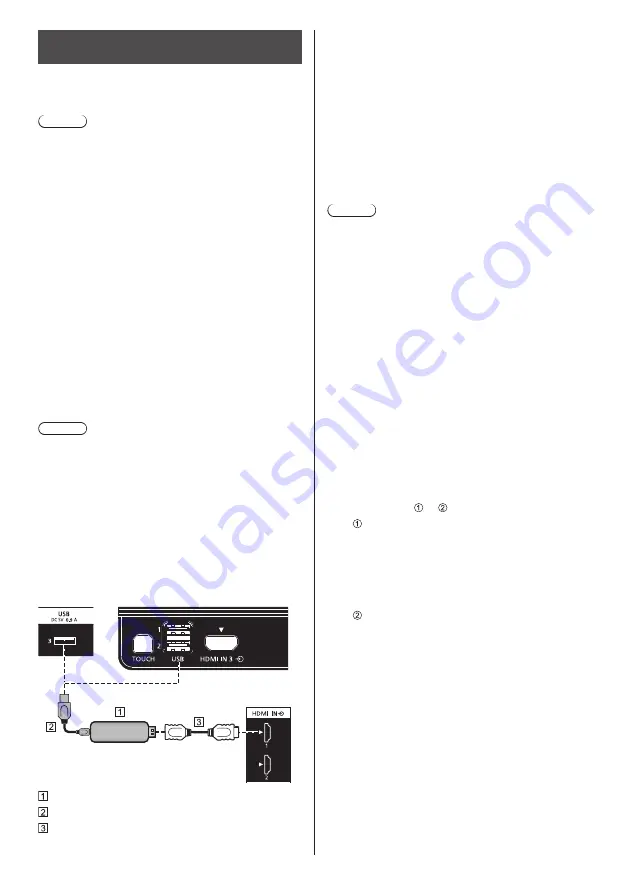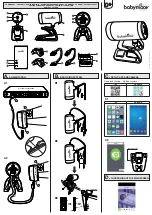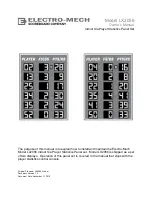
27
English
USB 1, USB 2 and USB 3 terminals
connection
Connect the USB memory (commercially available) to
use “USB media player” or “Memory viewer”. (see page
128, 140)
Note
●
This unit has two USB terminals on the front and one
USB terminal on the rear. To the terminals, a USB
device or USB memory is connectible.
●
In addition to the terminals mentioned above, this unit
has one USB terminal for TOUCH connection on the
front.
●
When more than one USB memory is connected, only
the first connected one is enabled.
●
When more than one USB memory is connected,
those connected second and later are disabled.
●
When more than one USB memory is connected, and
if all but one are disconnected, the last one remaining
connected is enabled.
●
When more than one USB memory is connected
when the unit is powered on, only one of them is
enabled depending on the specifications of the USB
memories. To enable a target USB memory when
the unit is powered on, connect only the target USB
memory when the unit is powered on.
Also, power is supplied when a separately sold stick PC,
etc. are connected.
Note
●
A stick PC and connection cables are not supplied
with this unit.
●
If the power is turned off or the USB memory device
is removed while accessing data in the USB memory
device, the stored data may be destroyed. The
access indicator of the USB memory device blinks
during data access.
●
The USB memory device can be connected or
disconnected whether or not the display is on.
●
USB 1 and USB 2 terminals on the front side and the
USB terminal of the function board cannot be used in
[Device operation mode].
Stick PC (commercially available)
USB cable (commercially available)
HDMI extension cable (commercially available)
When the picture is displayed, depending on the USB
terminal, following power can be supplied to an external
device.
Front side USB 1 and USB 2: 5V/0.5A
Rear side USB 3: 5V/0.9A
●
If the electric current exceeding the power supplying
capability is applied, the output is blocked, and the
following message is displayed.
[USB DC5V OUT overload. Please remove cable or
equipment, then turn the display off/on.]
In this case, remove the equipment and then turn the
power off/on using the remote control, etc.
Note
●
If the direct connection to this unit is not possible due
to the size of a stick PC, etc. use a commercially sold
extension cable.
●
Depending on the type of a USB memory device,
it may come in contact with the periphery such as
a back cover, and cannot be attached. Use a USB
memory device connectable to this unit.
●
When connecting the USB memory device, confirm
the orientation of the plug to prevent damage to the
terminal.
●
When removing the USB memory device, note the
following.
•
When the access indicator of the connected USB
memory device is blinking, it shows the display is
loading the data. Do not remove the USB memory
device while blinking.
•
Depending on the USB memory device, the access
indicator may remain blinking even when it is not
being accessed, or the device is not equipped
with an access indicator function, etc. In this case,
remove the USB memory device after confirming
the following or .
Switch the input to an input other than [USB],
[MEMORY VIEWER] and [WHITEBOARD],
and confirm that the functions that access USB
memory device are finished. The functions are,
read user image function (see page 93), playlist
edit function (see page 135), data cloning
function (see page 147), etc.
Turn the unit off.
•
Do not frequently repeat connecting/disconnecting
the USB memory device. Wait at least 5 seconds
after connection, and then remove the USB
memory device. Before reconnection, wait at least
5 seconds. A certain length of time is required
so that the display can recognise that the USB
memory device is switched for connection or
disconnection.
•
If the power of this unit is turned off or the USB
memory device is removed accidentally while
accessing data, the data may not be accessed
next time the USB memory device is used.
In such a case, turn the power of the main unit off
and on.
















































